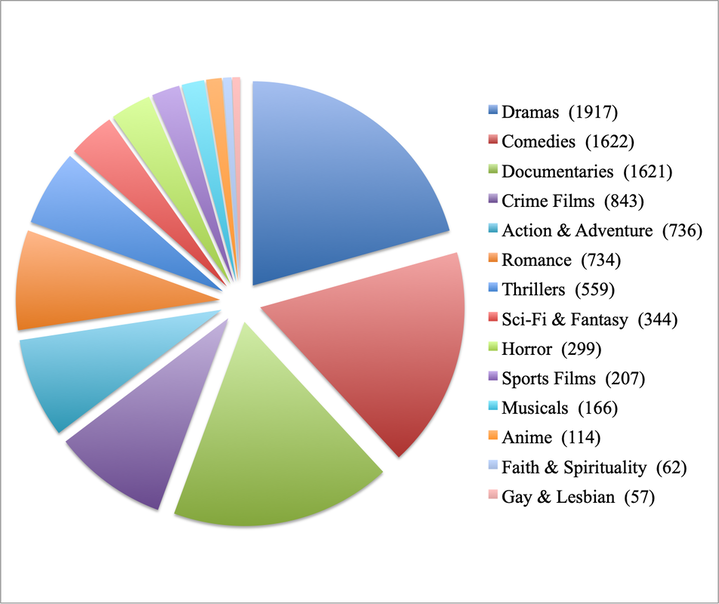|
If we want to grab attention from potential readers and viewers, we should know what is already competing for their attention. One way to do this is to be aware of the genres that Netflix invests the most money into. I compiled a list from https://www.whats-on-netflix.com/originals/movies/, and present the data here as pie charts: July 21, 2019 December 1, 2018 Nov 24, 2018
0 Comments
A lot of writers keep themselves up to date with current ways to make people laugh. In this Family Guy clip (0:00 - 1:20), we see the writers lampoon two styles of comedy writing. The common thread between the two appears to be (1) subtle mundaneness, and (2) extra support being necessary--the How I Met Your Mother jokes on TV would be accompanied by a laugh track that tells the audience what is supposed to be funny (and how funny, by the intensity of the laughter), and Brian's explains that you would have to know his aunt to find the joke funny. As a writer, we each are empowered to write about what we have personally experienced, and we are also limited by what we have not personally lived. More ideas on story-writing from people of different life experiences should populate this blog space and the stories we all write and read. If you are reading this, please feel free email me anything you think would help any writers in this space. As writers, it's important to build our stories around beliefs. David Foster Wallace is well known for his messages about connection and empathy toward the people we live around.
https://quotes.thefamouspeople.com/david-foster-wallace-4726.php What do we do with all of our many Wish List ideas that don't seem to fit anywhere in our stories? I write down a lot of ideas that end up in notebooks, and then just sit in those notebooks, possibly forever. Here are two examples of where such ideas can go--in the margins where they don't have to interfere with the main story. Audiences can go back and look, if and when they want to. The Simpsons did this whenever panning from one room to another, or in a quick exterior opening scene, where something topical would be written on a sign, or buried between walls or underground.
Image from The Good Place, Season 2 Episode 6 (5m34s) Here is a convenient list of story themes to choose from when planning your story. As soon as one theme catches your eye, the next step is to write out lies and truths that you find compelling to yourself, and that you can envision being compelling for your audience.
https://literarydevices.net/a-huge-list-of-common-themes/ Here's a list of sentences forming a descriptive sequence of events that I intend to make boring for the first reading, but interesting the second time around, and then I change the meaning again in a third round:
Sarah went to the kitchen. She washed the dishes. She dried the dishes. She checked that the dishes were clean. She found one more dish in the living room. She washed that dish. She dried that dish. She checked that that dish was clean. She swept the kitchen floor. She checked that the kitchen floor was clean. Sarah thought about how good she was at cleaning. Now I will copy this entire text, but add just a little extra to the beginning. Notice how the added beginning changes the implications of the entire reading copied from above: Sarah came home from another busy day at the office. Sarah's husband, Tim, always cleaned the house, but not today. Sarah came home and found Tim's lifeless body on the floor, surrounded in blood. Sarah held back tears. Sarah went to the kitchen. She washed the dishes. She dried the dishes. She checked that the dishes were clean. She found one more dish in the living room. She washed that dish. She dried that dish. She checked that that dish was clean. She swept the kitchen floor. She checked that the kitchen floor was clean. Sarah thought about how good she was at cleaning. Here it is one more time, but we'll make Sarah the murderer: Sarah and Mike were lovers until Mike discovered Sarah's source of income. Now, Sarah looked at Mike's cold frozen body in the basement freezer. Sarah went to the kitchen. She washed the dishes. She dried the dishes. She checked that the dishes were clean. She found one more dish in the living room. She washed that dish. She dried that dish. She checked that that dish was clean. She swept the kitchen floor. She checked that the kitchen floor was clean. Sarah thought about how good she was at cleaning. The reading should serve as a different experience with each change in the beginning because as we read we are not simply tracking actions, but tracking intentions along with those actions. Our understanding of the person's intentions in each iteration--first Sarah is simply cleaning, second she is doing her husband's work as possibly a kind form of denial of his death, and third she is doing normal housework to show how her life goes on as normal because killing is nothing special to her. Whatever they did just before the rest of the action marinates those actions in new meaning. Whether writing a graphic novel, a comic strip, or a short film, this is how you can go about writing your scene(s) with novice-level (or no) language. |
Reed RiggsWrite something about yourself. No need to be fancy, just an overview. ArchivesCategories |




 RSS Feed
RSS Feed
